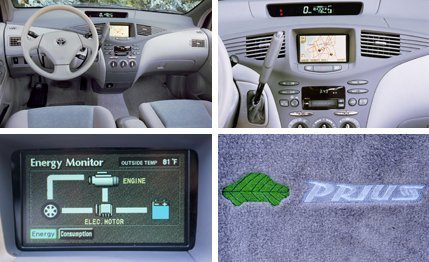TESTED
A Toyota Prius looks as if it’s rescuing the planet just sitting in the car park. The pudgy body is stripped of extraneous tinsel, and it tippytoes on four little donuts that look too delicate to bruise a snail darter. A waterfall could have shaped the minimalist cockpit, flushing away the grubby buttons and gauges that pollute other cars. The engine idles with a faint whisper and uses up just a gallon of gasoline every 45 to 52 miles, says the window sticker, puffing out few enough poisons to wear a federal SULEV (Super Ultra Low-Emission Vehicle) label. The steering is so fingertip feathery on the road that the Prius feels as though it’s gliding a few mills off the pavement.
So it can be no surprise that Toyota Motor Corp. enjoys its share of adulation from the Sierra Club, from Washington D.C. windbags, and from everyone else who conveniently forgets about the five models of sport-utilities and two models of pickups also peddled in Toyota dealerships. All, we might add, in far greater numbers than the roughly 4500 Priuses Toyota has so far showered on American byways.
|
|
Alas, for Earth-firsters the Prius and hybrid Honda Insight represent irrefutable proof that cars can be practical, affordable, and stingy. We will not attempt to wrestle with that logic here, only some of the facts behind it. Over 900 miles of mostly typical daily commuting, our Prius motored an average of 35 miles and 844 feet on every gallon of gas. That’s a zero-percent improvement over the Japanese home-market version we tested in February 1999 and 20 percent below the EPA’s official city rating.
A Nissan Sentra GXE tested last June as part of a 13-car comparison of entry-level sedans turned in 28 mpg. Toyota’s own five-speed Echo pulled a lofty 33-mpg on the same drive while offering nearly identical interior space, a 0-to-60-mph time 4.2 seconds quicker, and an as-tested price $6591 lower. And both do so without the motive aid and expense of an electric motor, a generator, a very nifty continuously variable planetary gear transmission, and four computers to run this sausage factory.
In fuel economy, the Prius should eat everyone’s lunch, but ours didn’t. So we rang Toyota to find out what we’re doing wrong.
The Prius does burn more fuel in northern winters, says Dave Hermance, Toyota’s executive engineer of environmental engineering for Toyota Technical Center USA. Frigid weather forces the 70-hp, 1.5-liter DOHC four-cylinder engine to stay lit to keep up coolant temperatures and drive the air conditioner, which runs automatically in defrost mode. In warmer climes the parallel hybrid saves fuel by quitting at stops and not restarting until the car is already in motion, propelled by the 44-hp flywheel electric motor.
|
|
Okay, we did drive our Prius through a period in which Lake Michigan tried to beach itself in the form of snow. So we are willing to concede that the EPA is at fault for neglecting to put an appropriate asterisk next to its fuel-economy rating that reads, specifically, “If you live north of the Mason-Dixon, all bets are off.” Although the Prius’s observed fuel-economy numbers haven’t changed since our last test, the performance on the EPA’s city/highway cycle has, says Toyota, from 43/41 to 52/45. Even though our Prius could not duplicate either the old or new EPA numbers, Hermance and his cohorts deserve at least some accolades for managing to hold the line on the as-tested figure, for much about the car has changed. Toyota boosted engine horsepower from 58 to 70 simply by raising maximum engine speed from 4000 rpm to 4500 rpm. That has added some desperately needed punch to the Prius’s acceleration, trimming its 0-to-60 time from 14.1 seconds to 13.0 seconds and its quarter-mile time from 19.7 seconds at 71 mph to 19.2 seconds at 73.
There’s no reason to fear retina detachment, but the engine does respond with a more eager snarl to swift kicks, and freeway merging feels less like riding into Turn One of the derby on Mr. Ed. The regenerative brakes are still touchy and difficult to modulate; they’re great in a panic stop from 70 mph, which consumes only 183 feet, but unmanageable on snow where they default to ABS on the first touch of toes.
View Photos
View Photos


Leave a Reply